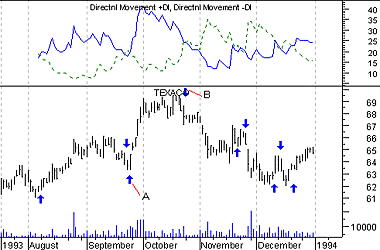
Technical Analysis from A to Z
by Steven B. Achelis
DIRECTIONAL MOVEMENT
Overview
The Directional Movement System helps determine if a security is "trending." It was developed by Welles Wilder and is explained in his book, New Concepts in Technical Trading Systems.
Interpretation
The basic Directional Movement trading system involves comparing the 14-day +DI ("Directional Indicator") and the 14-day -DI. This can be done by plotting the two indicators on top of each other or by subtracting the +DI from the -DI. Wilder suggests buying when the +DI rises above the -DI and selling when the +DI falls below the -DI.
Wilder qualifies these simple trading rules with the "extreme point rule." This rule is designed to prevent whipsaws and reduce the number of trades. The extreme point rule requires that on the day that the +DI and -DI cross, you note the "extreme point." When the +DI rises above the -DI, the extreme price is the high price on the day the lines cross. When the +DI falls below the -DI, the extreme price is the low price on the day the lines cross.
The extreme point is then used as a trigger point at which you should implement the trade. For example, after receiving a buy signal (the +DI rose above the -DI), you should then wait until the security's price rises above the extreme point (the high price on the day that the +DI and -DI lines crossed) before buying. If the price fails to rise above the extreme point, you should continue to hold your short position.
In Wilder's book, he notes that this system works best on securities that have a high Commodity Selection Index. He says, "as a rule of thumb, the system will be profitable on commodities that have a CSI value above 25. When the CSI drops below 20, then do not use a trend-following system."
Example
The following chart shows Texaco and the +DI and -DI indicators. I drew "buy" arrows when the +DI rose above the -DI and "sell" arrows when the +DI fell below the -DI. I only labeled the significant crossings and did not label the many short-term crossings.

Calculation
The calculations of the Directional Movement system are beyond the scope of this book. Wilder's book, New Concepts In Technical Trading, gives complete step-by-step instructions on the calculation and interpretation of these indicators.
Contents
- Preface
- Acknowledgments
- Terminology
- To Learn More
- Bibliography
- About the Author
- Technical Analysis
- Price Fields
- Charts
- Support & Resistance
- Trends
- Moving Averages
- Indicators
- Market Indicators
- Line Studies
- Periodicity
- The Time Element
- Conclusion
- Absolute Breadth Index
- Accumulation/Distribution
- Accumulation Swing Index
- Advance/Decline Line
- Advance/Decline Ratio
- Advancing-Declining Issues
- Advancing, Declining, Unchanged Volume
- Andrews' Pitchfork
- Arms Index
- Average True Range
- Bollinger Bands
- Breadth Thrust
- Bull/Bear Ratio
- Candlesticks - Japanese
- CANSLIM
- Chaikin Oscillator
- Commodity Channel Index
- Commodity Selection Index
- Correlation Analysis
- Cumulative Volume Index
- Cycles
- Demand Index
- Detrended Price Oscillator
- Directional Movement
- Dow Theory
- Ease of Movement
- Efficient Market Theory
- Elliott Wave Theory
- Envelopes (Trading Bands)
- Equivolume/Candlevolume
- Fibonacci Studies
- Four Percent Model
- Fourier Transform
- Fundamental Analysis
- Gann Angles
- Herrick Payoff Index
- Interest Rates
- Kagi
- Large Block Ratio
- Linear Regression Lines
- MACD
- Mass Index
- McClellan Oscillator
- McClellan Summation Index
- Median Price
- Member Short Ratio
- Momentum
- Money Flow Index
- Moving Averages
- Negative Volume Index
- New Highs-Lows Cumulative
- New Highs-New Lows
- New Highs/Lows Ratio
- Odd Lot Balance Index
- Odd Lot Purchases/Sales
- Odd Lot Short Ratio
- On Balance Volume
- Open Interest
- Open-10 TRIN
- Option Analysis
- Overbought/Oversold
- Parabolic SAR
- Patterns
- Percent Retracement
- Performance
- Point & Figure
- Positive Volume Index
- Price and Volume Trend
- Price Oscillator
- Price Rate-of-Change
- Public Short Ratio
- Puts/Calls Ratio
- Quadrant Lines
- Relative Strength, Comparative
- Relative Strength Index
- Renko
- Speed Resistance Lines
- Spreads
- Standard Deviation
- STIX
- Stochastic Oscillator
- Swing Index
- Three Line Break
- Time Series Forcast
- Tirone Levels
- Total Short Ratio
- Trade Volume Index
- Trendlines
- TRIX
- Typical Price
- Ultimate Oscillator
- Upside/Downside Ratio
- Upside/Downside Volume
- Vertical Horizonal Filter
- Volatility, Chaikin's
- Volume
- Volume Oscillator
- Volume Rate-of-Change
- Weighted Close
- Williams' Accumulation/Distribution
- Williams' %R
- Zig Zag